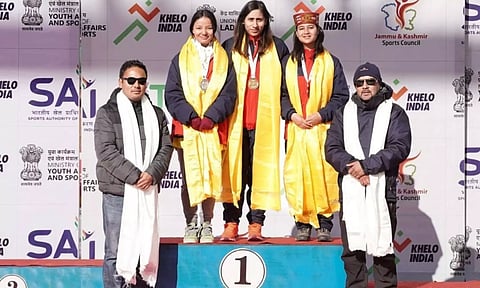

NEW DELHI: India’s top skaters believe the start of the Khelo India Winter Games in Ladakh could be a gamechanger for ice-sports although a lot remains to be done.
Shruti Kotwal, India’s first professional long track skater based in the United States, and Akash Aradhya, a veteran in short-track sprinting, feel the recently concluded KIWG at Leh held out significant promises for skaters with long-term aspiration.
In ice-skating, Kotwal and Aradhya, have been there, done that and are seeing the transformation of winter sports in India. With plenty of international experience behind them, Shruti Kotwal and Akash Aradhya, who won a pair of long track and short track Khelo India Winter Games 2024 gold medals each in Leh, think the Nawang Dorjay Stobdan (NDS) ice rink, in the heart of Leh, could become the headquarters of ice sports if it can become an all-weather centre.
Shruti Kotwal was back in India for the first time in 10 years. She competed at Guphuks Pond, a natural water body alongside the Indus River and surrounded by the Zanskar Range that freezes in winter and becomes a skating and ice hockey rink for local Ladhakis. But such rinks are not ideal for top-level competitions that need surfaces to be mirror smooth, well defined tracks and above all, protection along the perimeter.
Short track and long track skating are very different. While long track is all about timing (time trials), short track is a combination of speed and skills to outwit each other in a group race, very much like Formula One. In long track, where skaters try to record their best timings, athletes don’t wear a helmet since air friction thwarts good timing. In short track, helmets are mandatory because skaters collide and skid to crash against the side boards.
Both Kotwal and Aradhya stress on the need for year-round training and the knowhow to maintain rinks, improve safety standards and manage injuries. “The first and foremost thing needed to maintain ice is a Zamboni (an ice-resurfacer vehicle that cleans and smoothens the ice in a rink). There can be no international tournament without it. Along with that, you need experienced Zamboni drivers and ice maintenance crew that knows how to fix damage on ice after crashes and accidents. More importantly, rink safety must meet International Skating Union standards,” says the US-based Kotwal.
With very few facilities available for top skaters to hone their skills continuously, the NDS complex certainly holds out hope. It’s first impression with India’s top skaters during the Khelo India Winter Games has been good.
Aradhya says: “The NDS rink could significantly improve India's prospects in the sport, especially now that Ladakh will also have a Sports Authority of India sponsored Centre of Excellence that can possibly include ice sports, a natural strength of the region.” Additionally, Aradhya underscores the advantage of training at higher altitudes that helps athletes adapt to the rigours of competing in venues at elevated levels.
The Khelo India Winter Games in Ladakh has exposed fresh talent and interestingly, they are from regions like Maharashtra, Uttar Pradesh, Telangana and Madhya Pradesh. It is a fact that most skaters start as roller skaters and then switch to ice skating because that’s still a very niche domain and winning national and international colours are relatively easier.
In Leh, a clutch of under-17 speed skaters, both long and short formats, caught the eye. Hyderabad’s Nayana Sri Talluri, Uttar Pradesh’s Eklavya Jagal, Maharashtra’s Aarav Patwardhan and Advay Kothari, Karnataka’s Srivatsa Rao, Ladakh’s Skarma Tsultim and Padma Angmo, and Madhya Pradesh’s Udreka Singh looked impressive. But that’s not enough.
“Future looks promising but its needs to speed up. An athlete needs to focus only on training, nutrition and competitions. If you are lucky to not stress about other aspects like the financial burden and responsibility of paying for your sport then results will definitely be in your favour,” says Kotwal, adding that rules and regulations keep changing and officials in India need to stay updated.
“We need more quality officials like certified starters, referees, timers. It is important that all these officials are trained well so they can host the event well and spread the awareness,” said Kotwal, who wants to qualify for the 2026 Winter Olympics.
Aradhya advocates specialised training to compete with the best. India’s flag-bearer at the opening ceremony of the 2017 Asian Winter Games in Japan insists “having a coach who can guide you to the international stage is vital.” Since 2012, Akash Aradhya has been training scientifically under Pinakin Ayere, a professional coach with a Master's degree in Sport and Exercise Science from Leeds Beckett University, West Yorkshire. Since then, he has consistently qualified for the national Team, ranking in the top 2 spots regardless of age category. “Training without proper and scientific supervision is a waste of time and money,” he emphasizes.
The Khelo India Winter Games in Leh may not have seen great timings but there was an abundance of intent. How the national ice skating federation in association with the states and Union Territories take advantage of this remains to be seen. Aradhya is hopeful.
"At the main Asian level with China, Korea, and Japan, we are not at all close to them. However, at the Southeast Asian Level, we compete well against countries like Singapore, Philippines, Indonesia, and Malaysia. Despite not having full-time ice rinks, our skaters perform admirably, showcasing our talent," he pointed out.